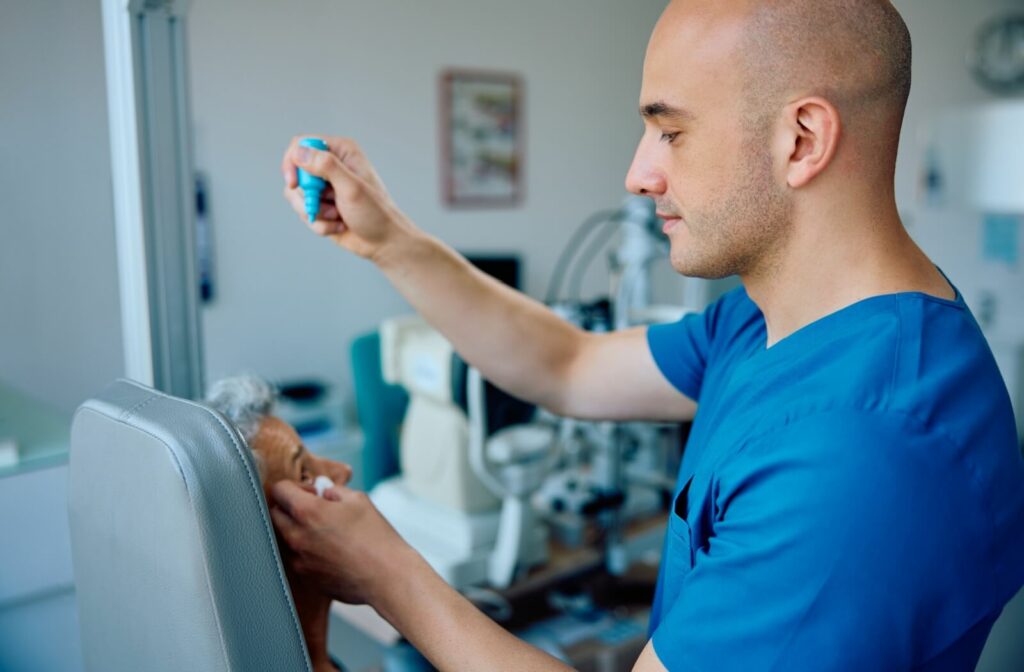Clear vision is crucial for safe driving, and regular eye exams are vital in maintaining it. The possibility of driving post-exam is a common concern among many adults.
Depending on the tests or procedures conducted, you may experience temporary light sensitivity or blurry vision. In some cases, your vision might not be affected and you’ll be able to drive right away.
However, there’s no one-size-fits-all answer to this question. The tests that your eye doctor takes are tailored to your specific needs, so make sure you follow your eye doctor’s personalized instructions.
Driving After an Eye Exam
You’ve just completed your eye exam. Now what?
Depending on the eye tests conducted, your vision might be temporarily affected. Dilated eyes, for instance, can blur your vision for several hours.
Dilated eye exams allow your doctor to check your retina and optic nerve thoroughly. But it can leave you sensitive to light and unable to focus properly. Pupil dilation is often part of a comprehensive eye exam or diabetic eye exam. The test helps your eye doctor see inside your eye and check for certain conditions and diseases.
If you’ve had numbing drops administered for intraocular pressure testing, you might experience mild blurriness. While these effects are short-lived, they can still impact your driving. Knowing how different eye tests can affect your vision helps you make informed decisions about driving after your appointment.
Vision acuity tests, which measure the sharpness of your vision, usually have no lingering effects. Similarly, tests for peripheral vision and depth perception might cause brief discomfort but won’t impair your driving ability.
You should follow your optometrist’s direction on how long you should wait to drive following your exam.
What Happens During an Eye Exam?
The first set of tests during a comprehensive eye exam is typically part of the initial assessment. These preliminary tests help set the stage for the more extensive examination later.
Family & Medical History
Your eye doctor will typically ask questions about your family and medical history. This portion of the appointment may be longer or shorter depending on the last time you’ve been in for an eye exam.
Visual Acuity
The Snellen chart is a poster with rows of letters that decrease in size. Most people may be familiar with this chart. It helps measure how well you see at various distances. This test can determine your need for corrective lenses.
Eye Pressure
Also known as tonometry, this test measures the pressure inside your eye. Elevated eye pressure can be an early indicator of glaucoma, a condition that can lead to blindness if untreated.

Pupil Dilation
Eye drops are used to widen your pupils. Not every exam will include pupil dilation, but it’s a crucial part of many of them, allowing your eye doctor to view your eye’s internal structure better.
Comprehensive Eye Examination
Once the initial assessments are complete, you’ll move on to the comprehensive eye examination. This includes a variety of tests designed to evaluate different aspects of your eye health.
Refraction Test
Using a device called a phoropter, you’ll look through various lens combinations. This test helps determine your exact prescription for glasses or contact lenses by identifying refractive errors like myopia and hyperopia.
Slit-Lamp Examination
The slit-lamp is a specialized microscope that allows your optometrist to examine the front part of your eye, including the cornea, iris, and lens. This exam can detect conditions like cataracts, corneal ulcers, and other abnormalities.
Retinal Examination
By shining a bright light into your dilated pupils, the optometrist can view the back of your eye, including the retina and optic nerve. This test can reveal signs of retinal detachment, macular degeneration, and diabetic retinopathy.
Post-Eye Exam Care
Once your eye exam is complete, there are several guidelines you should follow to ensure your eyes recover properly.
Dealing with Dilated Pupils
Pupil dilation can make your eyes more sensitive to light and temporarily impair your vision. Wearing sunglasses can help reduce harsh light and discomfort.
Rest Your Eyes
It’s a good idea to rest your eyes post-exam, especially if you’ve undergone multiple tests. Avoid using screens and reading fine print for a few hours to prevent eye strain.
Follow Your Optometrist’s Advice
Always adhere to any specific guidelines your optometrist provides. This could include using prescribed eye drops or scheduling follow-up appointments.
Don’t Let Post-Exam Circumstances Keep You from Your Eye Exam
Regular eye exams help maintain clear vision, but depending on the tests, your vision might experience temporary changes. Understanding the immediate effects of eye tests, comprehending your exam results, and implementing safety tips can help you manage your driving post-exam.
Your vision is vital for road safety—taking steps to protect it benefits everyone. Call our team at Vision Care Grayslake today to book your next eye exam, and let us help you keep your eyes healthy and ensure you’re ready for the road ahead.




